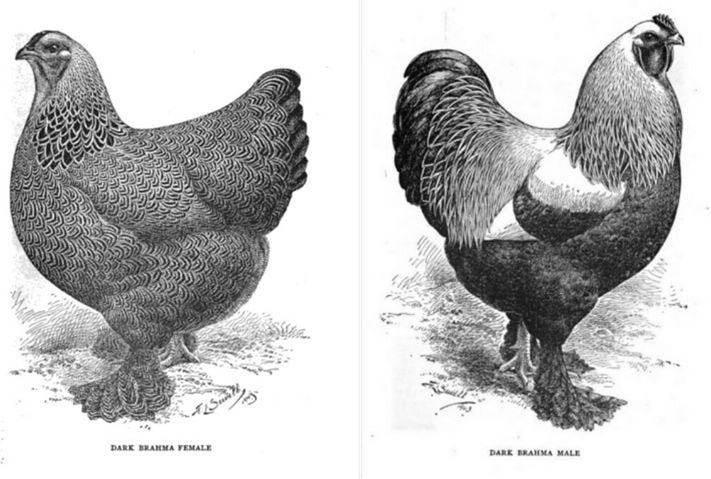Utility
Most people know Brahmas as a layer breed. They are good layers averaging 3-4 light brown eggs per week. They are a very cold hardy breed and are known to be superior winter layers. Some people are surprised to learn that Brahmas are actually a dual purpose breed. In fact, they were the most popular meat breed in the United States until the early 1900's. They have a great quantity of flavorful, nutritious dark meat and a large individual can easily feed a whole family.
Temperament
One of the things that initially drew us to Brahmas was their temperament. They are extremely docile and easy to handle, including the roosters. This has made them a favorite among families who want a large and beautiful flock protector that they can also trust around their children. They have more than earned their reputation as "gentle giants".
Appearance
In addition to their practical attributes, many people are drawn to Brahmas by their stunning appearance. They are one of the largest breeds around and their abundant fluff can make them appear larger than a chicken has any right to be. Their height, width, ample foot feathering, and scowl combine to make a very unique looking breed. However, all of these traits are easily lost without careful selective breeding. This is why some individuals from hatcheries and less particular breeders can be barely recognizable as Brahmas.
Varieties
There are only three color varieties recognized by the American Poultry Association: light, dark, and buff. However, there are a number of gorgeous colors that are standard for Brahmas in other countries. Many of these colors have been gaining popularity here in the United States.
Unfortunately, it can be very difficult to find nonstandard colors that otherwise fit the Brahma Standard of Perfection and have all the easily recognizable Brahma traits described above. This is because nonstandard varieties in the United States were either 1) imported from other countries where the Brahma Standard of Perfection is a bit different, or 2) created here by crossing Brahmas with other breeds to bring in another color. Common flaws include incorrect comb types, weak brows, incorrect tail sets, sparse leg feathering, and poor pattern definition, to name a few.
Here at Feather & Fern Farmstead, we focus on a small number of nonstandard varieties. We are dedicated to improving type in these varieties and eliminating the flaws discussed above. This can only be accomplished through years of very selective breeding and is part of why our flocks are so small: we only keep the best. Our goal is to produce beautiful colors not often seen in the United States while still striving towards the Brahma Standard of Perfection.
Most people know Brahmas as a layer breed. They are good layers averaging 3-4 light brown eggs per week. They are a very cold hardy breed and are known to be superior winter layers. Some people are surprised to learn that Brahmas are actually a dual purpose breed. In fact, they were the most popular meat breed in the United States until the early 1900's. They have a great quantity of flavorful, nutritious dark meat and a large individual can easily feed a whole family.
Temperament
One of the things that initially drew us to Brahmas was their temperament. They are extremely docile and easy to handle, including the roosters. This has made them a favorite among families who want a large and beautiful flock protector that they can also trust around their children. They have more than earned their reputation as "gentle giants".
Appearance
In addition to their practical attributes, many people are drawn to Brahmas by their stunning appearance. They are one of the largest breeds around and their abundant fluff can make them appear larger than a chicken has any right to be. Their height, width, ample foot feathering, and scowl combine to make a very unique looking breed. However, all of these traits are easily lost without careful selective breeding. This is why some individuals from hatcheries and less particular breeders can be barely recognizable as Brahmas.
Varieties
There are only three color varieties recognized by the American Poultry Association: light, dark, and buff. However, there are a number of gorgeous colors that are standard for Brahmas in other countries. Many of these colors have been gaining popularity here in the United States.
Unfortunately, it can be very difficult to find nonstandard colors that otherwise fit the Brahma Standard of Perfection and have all the easily recognizable Brahma traits described above. This is because nonstandard varieties in the United States were either 1) imported from other countries where the Brahma Standard of Perfection is a bit different, or 2) created here by crossing Brahmas with other breeds to bring in another color. Common flaws include incorrect comb types, weak brows, incorrect tail sets, sparse leg feathering, and poor pattern definition, to name a few.
Here at Feather & Fern Farmstead, we focus on a small number of nonstandard varieties. We are dedicated to improving type in these varieties and eliminating the flaws discussed above. This can only be accomplished through years of very selective breeding and is part of why our flocks are so small: we only keep the best. Our goal is to produce beautiful colors not often seen in the United States while still striving towards the Brahma Standard of Perfection.


